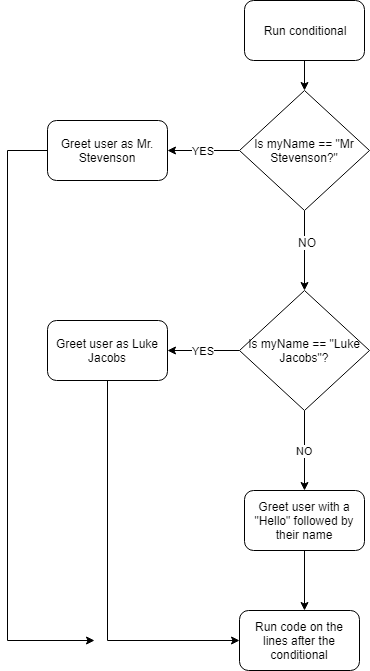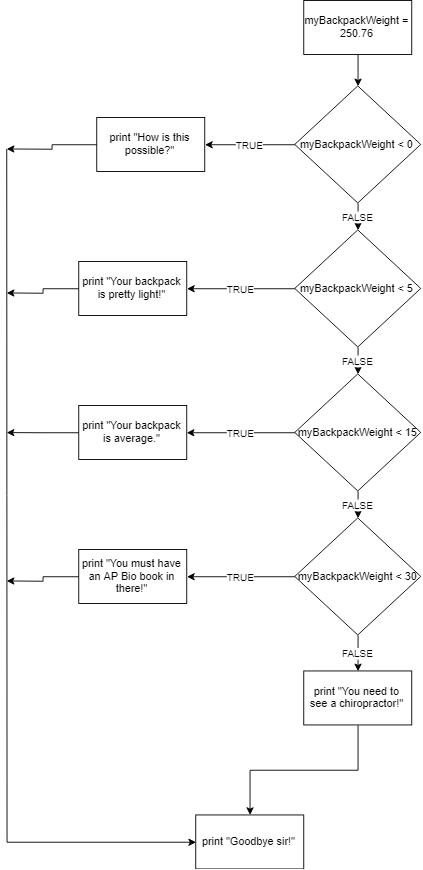What are conditionals?
Conditionals are blocks of code that only run if a certain condition is true.
Conditional Format
if condition:
do
something
if condition is true
elif condition2:
do
something
if condition2 is true
[you can insert some more elif blocks here]
else:
do something
if neither condition is true
Conditionals ALWAYS have at least an if, a condition that follows, a colon, and an indented block of code that follows on the next lines. Conditionals can have an unlimited amount of elif blocks. elif stands for else if, which means if the previous condition was False, the program will test this condition. Finally, you can add an optional else block which runs its indented code section if ALL of the previous conditions were false. I’m sure you did not absorb all of that, so let’s look at a specific example!
Specific Examples
You will almost always use comparison operators and logical operators to build conditions.
myName = "Caillou"
myAge = 21
if myName == "Mr Stevenson":
print "Hello monk!"
elif myName == "Luke Jacobs":
print "Hello teacher/scholar/genius!"
else:
print "Hello " + myName #this combines the two strings into one
This example greets someone based on their name. If the person’s name is “Mr Stevenson” or “Luke Jacobs”, it greets that person in a special way. If the person has any other name, the program will greet them with simply a “Hello” followed by a space and then their name. Let’s look at the flow of this program. This program makes two comparisons and responds in a different way depending on what the value of myName is. The first two lines are simple because it’s just 2 variable initializations. When the program gets to the if, it has two forks in the road that it can go down. Either it can greet them as Mr. Stevenson, or it can just keep going. In this case, it will just keep going because myName == "Mr Stevenson" is False. If that condition was true, then it would run the indented code section and skip to the end of the conditional. So now our program is at the elif. Our program has another fork in the road. Either it can greet the user as Luke Jacobs or it can move on. myName == "Luke Jacobs" is false, so the program moves on through the conditional. It comes to the end of the condition which is an else block. An else block is ALWAYS run if the program gets to that point in the conditional. This means that if myName == "Mr Stevenson" AND myName == "Luke Jacobs" were BOTH False, then the else block would run. It essentially tells the program to do something if every other test before it is False. I hope this flowchart helps you visualize what is going on:

This flowchart helps you see all the branches that a program can go down. In a real-world program, you might see thousands of branches leading to thousands of other branches, allowing the program to end up in billions of different places.
More Examples
#Example 1
if True:
#this code is ALWAYS run
elif True:
#this code is NEVER run, since the condition before it is ALWAYS true
else True:
#this code is NEVER run, since at least one condition before it is true
#Example 2
if 2 + 2 == 5:
#this code is NEVER run, since the condition is ALWAYS False
elif True:
#this code is ALWAYS run, since the condition before it is false and this condition is ALWAYS true
#Example 3
myBackpackWeight = 250.76 #weight in pounds
if myBackpackWeight < 0:
print "How is this possible?" #run if weight is negative
elif myBackpackWeight < 5:
print "Your backpack is pretty light!" #run if 0 < weight < 5
elif myBackpackWeight < 15:
print "Your backpack is average." #run if 5 < weight < 15
elif myBackpackWeight < 30:
print "You must have an AP Bio book in there!" #run if 15 < weight < 30
else:
print "You need to see a chiropractor!" #run if weight >= 30
print "Goodbye sir!"

Exercises
- Is
(True and False) or (False)equal toTrueorFalse? - What is the use of conditionals to programmers?
- What does
elifstand for and what is its purpose? - What might be one example of a program that uses a conditional?
- When does an
elseblock run? -
What is the value of
aafter this code?if (7 == 0) and (b == 5): a = 10 elif 0 < -7: a = 7 else: a = 4 - Write a conditional that prints
"Bust!"ifcardsValueis greater than 21 and"Hit or Stand?"ifcardsValueis less than that amount.